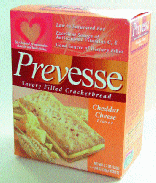
Larch arabinogalactan (AG) is one such tool for food formulators. AG is a naturally occurring, water-soluble polymer found in high concentrations in the Larix genus of trees. Not only does AG function as a prebiotic fiber and immune enhancer, it also retains moisture, enhances mouthfeel and bulk, and improves shelf stability.
Because of AG's low-viscosity profile and emulsification enhancing properties, the most ready applications include refrigerated and non-refrigerated beverages, and beverage mixes. Interest has also been expressed for snack foods, bars, ready-to-eat cereals, yogurt/dairy products and baked goods, says Lori Siegler, product manager, Larex Inc., St. Paul, Minn.
Commercially available larch AG-containing products include beverages and nutrition bars. The Hain Celestial Croup, Boulder, Colo., uses AG in its Echinacea line of Wellness Teas. Glacéau, Whitestone, N.Y., adds AG to its Wellness Waters for immune system enhancement. Procter & Gamble, Cincinnati, is currently test marketing an AG-fortified wafer to supplement the average fiber-poor U.S. diet.
Not only does AG add nutrition, it also provides functional benefits. "An independent food laboratory confirmed that the inclusion of AG improved white pan bread make-up, external symmetry and internal grain scores," says Siegler. "Fat-free flour tortillas with AG showed better handling, taste and aroma than the control."
Larex also identifies AG as a low-calorie additive for artificial sweeteners, delivering the mouthfeel, taste and bulking attributes most like sugar.
In confectionery and baked goods, AG lowers water activity and aids flavor and oil retention. AG can be used in browning compositions for uncooked foods, in seasoning powders to improve flow and reduce hygroscopicity, and in starch-containing foods to inhibit swelling, adds Siegler.
Recent clinical investigations have demonstrated not only benefits to gastrointestinal health and immunity, but also a significant reduction in serum cholesterol, glucose and insulin levels. This opens the door to potential heart health label claims and provides an option to consumers looking for foods beneficial in terms of body weight, blood glucose or blood insulin control.

erAidw brands of arabinogalactan. This six month, double-blind placebo-controlled study followed 100 adult subjects on free-living diets. The study substantiated AG's prebiotic and immune-enhancing effects. Results showed significant increases in total gut anaerobes, including beneficial gastrointestinal bacteria. More importantly, the study confirmed a marked reduction in cholesterol levels in the hyperlipidemic subjects.
In vitro cell studies have demonstrated that AG is the active immune stimulatory compound in echinacea and that Larix AG stimulates the human immune system greater than echinacea. Two human feeding studies at the University of Minnesota and Southwest College Research Institute demonstrated the immune stimulation effects in vivo. Consumption of larch AG led to increased levels of immune system white blood cells, specifically monocytes, and activated the complement immune system.
"The physiological benefits as determined by human and animal clinicals have been seen at levels as low as 1.5 g/day, or more specifically at 20 mg/kg of body weight," says Siegler. "AG has been found to be totally safe as a food ingredient. On average, finished products containing a minimum of 60 mg/kg of body weight or about 4.5 g/day is recommend for foods."
Arabinogalactan is the active ingredient in both Larex ImmunEnhancer and Larex FiberAid. Both products add nutrition and functional benefits to dietary supplements and foods.